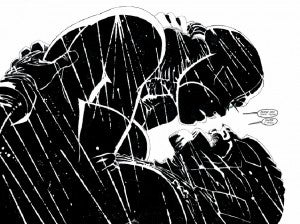When Frank Miller first introduced the idea of a Batman propaganda comic wherein he fights Islamic terrorists, it seemed a bit crazy.Granted, he was right that both Superman and Captain America had punched out Hitler in the pages of ’30s and ’40s-era stories. Still, to argue that those stories weren’t a byproduct of a less cynical time seemed a bit silly. The title that started to be bandied about–Holy Terror, Batman!, a reference to Burt Ward’s “Holy _____” catchphrase of the ’60s TV show, made the whole thing seem even more preposterous. Still,in interviews Miller sounded totally earnest. As a New Yorker, he said, he had seen the ugliness and the hate up-close. Patriotism was, to Miller, part of the recipe for bringing Al Qaeda to their knees.And, of course, in both of those old stories the heroes in question were on the offense, taking the fight to the Nazis in their homeland. No longer a DC title, and therefore lacking Batman, Miller’s Holy Terror (out this week) is a totally different animal. Miller’s fictional “Empire City,” neither Gotham nor New York exactly, is a city under siege in the graphic novel–a war zone where there’s dust and fire in the air, as dozens of suicide attacks are launched near-simultaneously by an orchestrated gang of Islamic terrorists with “stinger missiles and no regard for human life.”Holy Terror is both the first outing for publisher Legendary Comics (a division of Legendary Pictures, who have had their hands in comic-related properties for years including the film adaptations of 300 and Watchmen) and released just in time to capitalize on a wave of morbid nostalgia that’s taken over the media and the public imagination following the tenth anniversary of the September 11 attacks. With projects coming up from Paul Pope and Matt Wagner, Legendary has positioned itself as a player right out of the gate in a way that no comics startup has since the early days of imprints like CrossGen and Black Bull. They’ve also got a pretty solid relationship with Miller, having a hand in 300: Batle of Artemisia when it hits cinemas. All that said, this has all the hallmarks of another dud from Miller following on the heels of his last two much-hated Batman projects and the abominable reviews of his film adaptation ofThe Spirit.As with all of Miller’s recent work, the art is highly stylized and reminiscent of his Sin City style. While there are moments where the speckled, paint-splattered look of Miller’s work really aids the story (such as immediately following a blast when theair is described as so thick that breathing it in causes a character to throw it back up), there are places where his art style doesn’t serve this story well at all; it’s often nearly impossible to understand what’s going on and there’s often little or no background work. It’s a style choice, of course (and much has been said about the less-is-more effect in Sin City, so the style is hard to question except for when it simply doesn’t work), not laziness…but at this point Miller’s style has become so self-referential that it’s almost parody and there are times in this book where it’s better suited to being pinups or something displayed in a pop art gallery than it is at anything resembling storytelling. There are stretches of several wordless pages at a time filled with frantic images that make no narrative sense and disrupt the storytelling completely. Some seem designed to make the reader think, but as often as not they come off as nonsensical–arbitrary collages of images that represent Miller’s vision of America.The “splash of color” approach that he’s taken with Sin City and The Spirit film is on display in this book–but it too seems like an arbitrary gimmick most of the time and only really adds anything to the narrative in the predictable climactic sequence.At the same time, he periodically comes out of this to present something that’s genuinely interesting, and the better moments (including a six-page splash featuring the faces of everyday people affected by terrorism and some truly kinetic, impressive storytelling at the beginning of the book) are both clever and sometimes even touching, lending what is otherwise a foul-mouthed and violent book a poignancy and intelligence that’s frankly surprising from a book that started out as being called “Batman Vs. Al Qaeda.” Frankly, one has to wonder whether it would have happened at all if Miller hadn’t been working on The Dark Knight Strikes Again in 2001 when the World Trade Center fell.










